
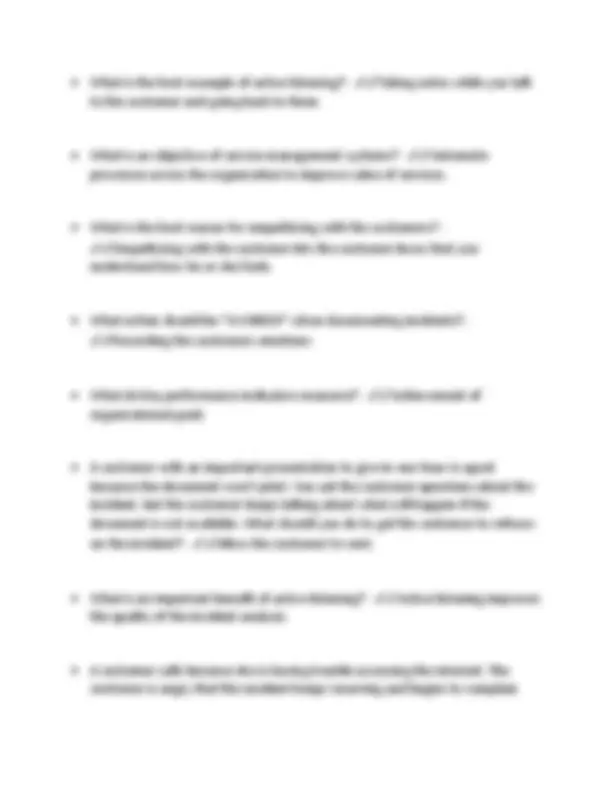
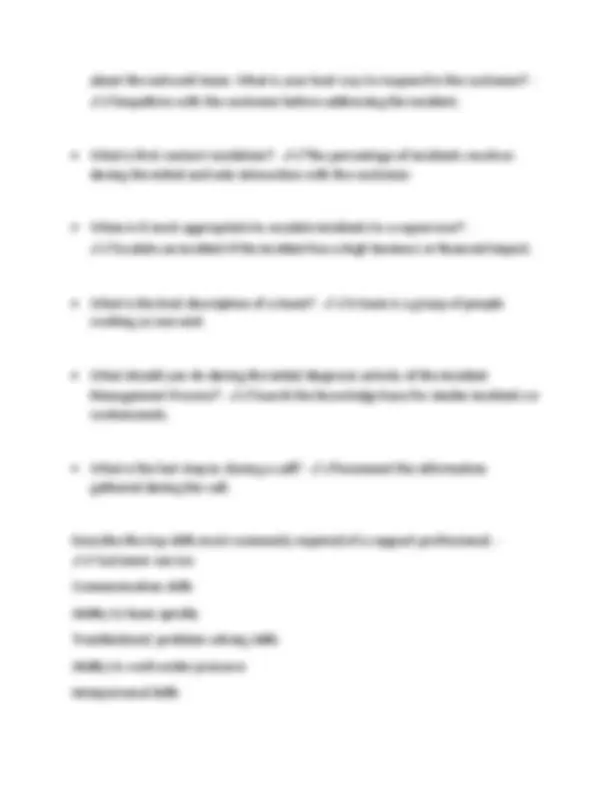
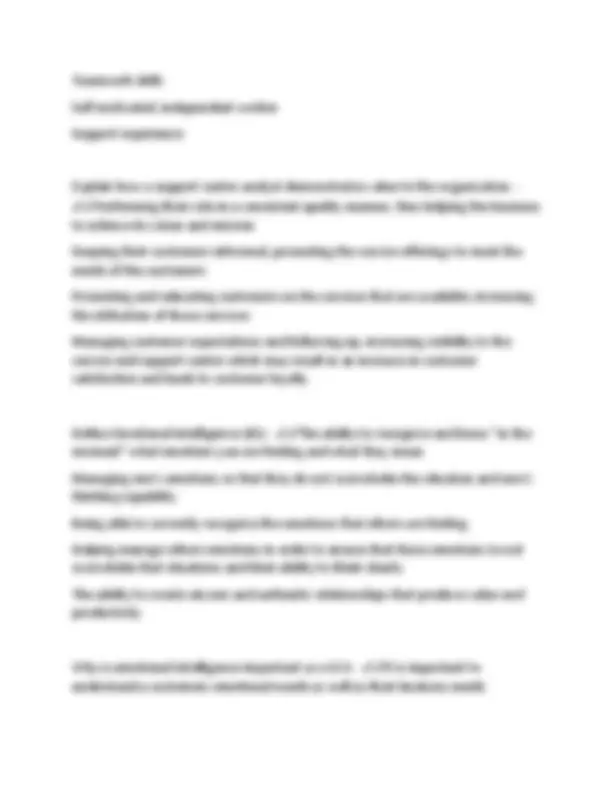
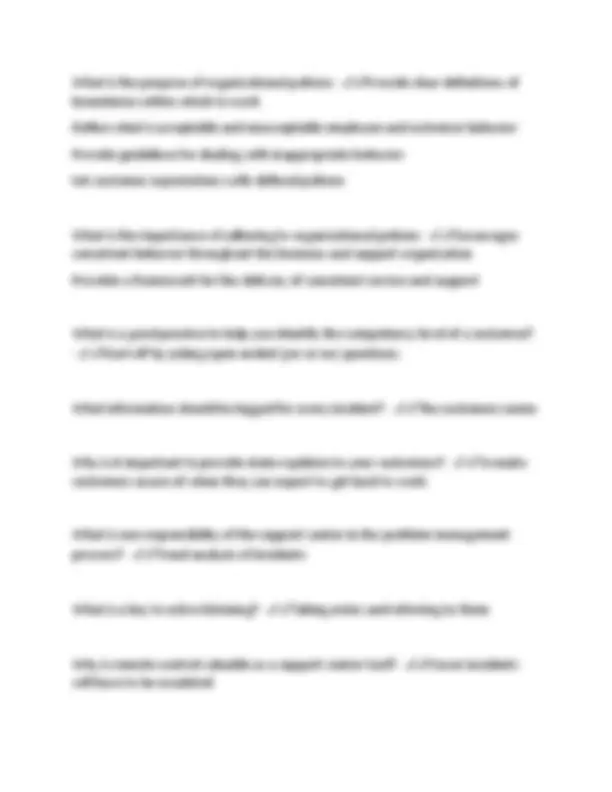
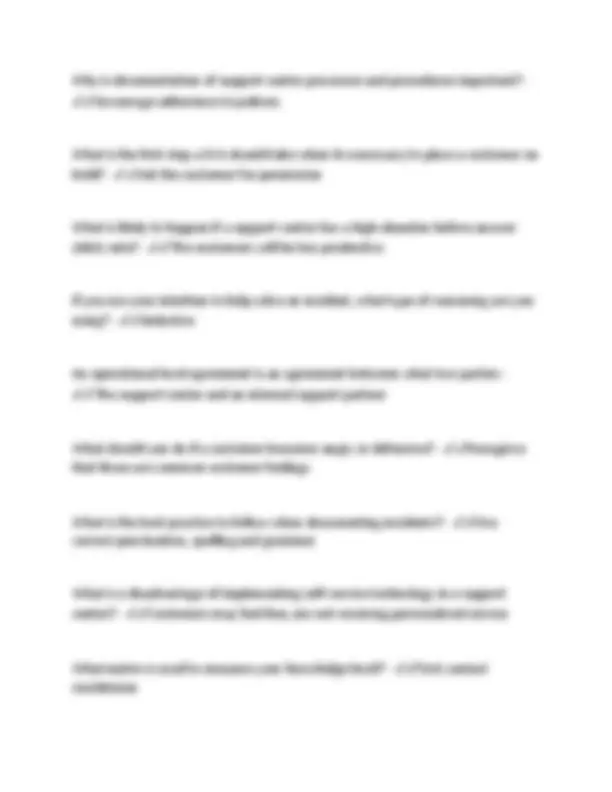
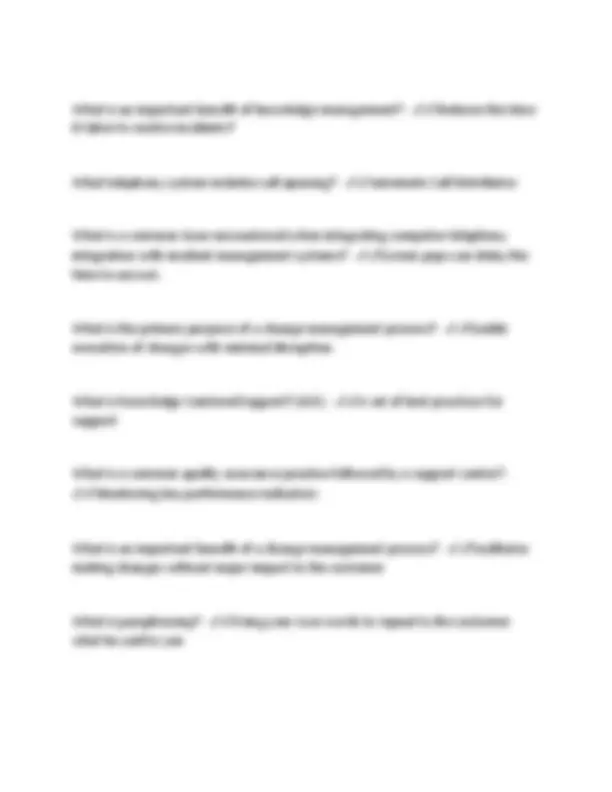
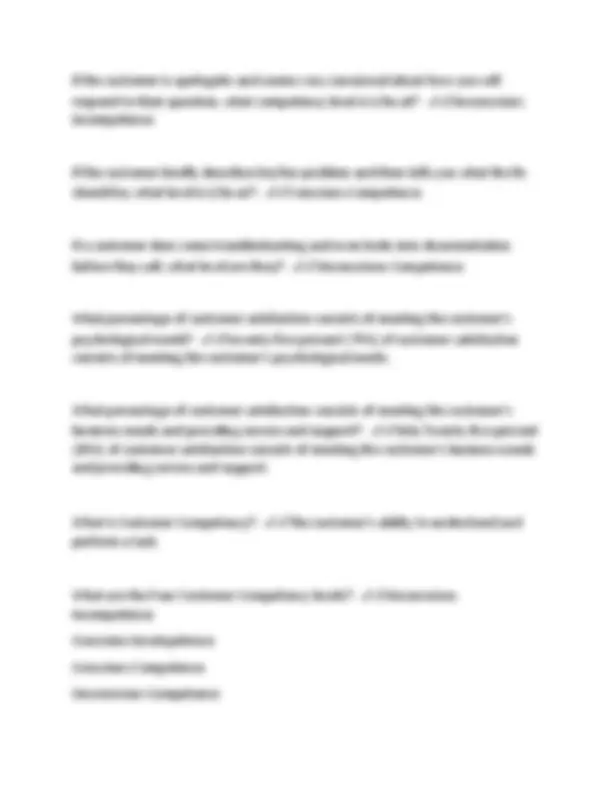
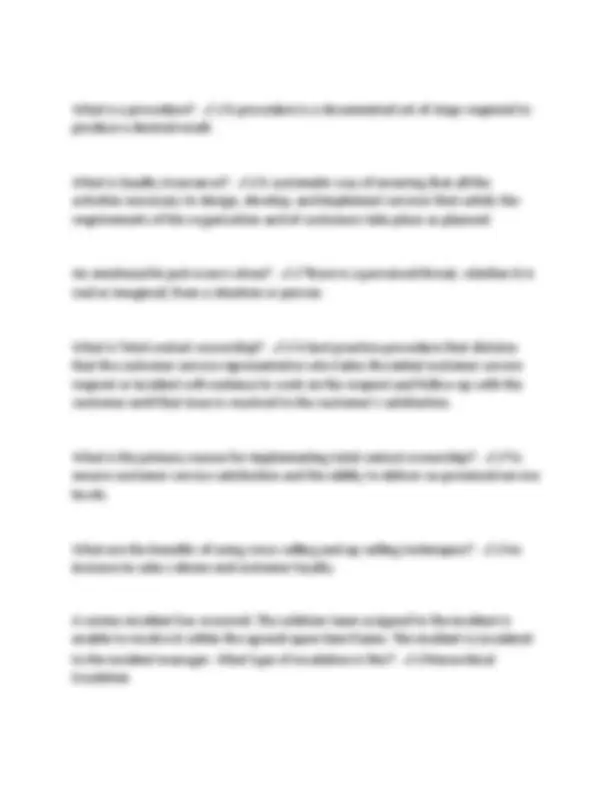
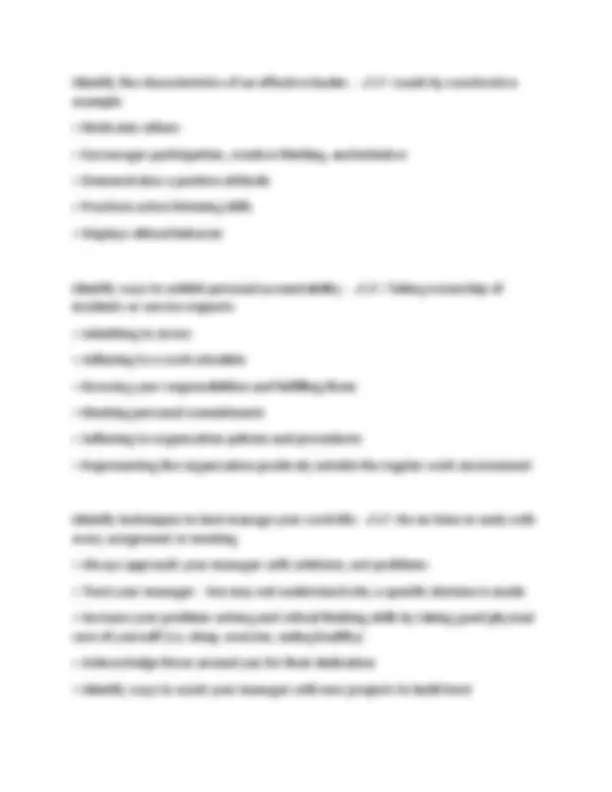
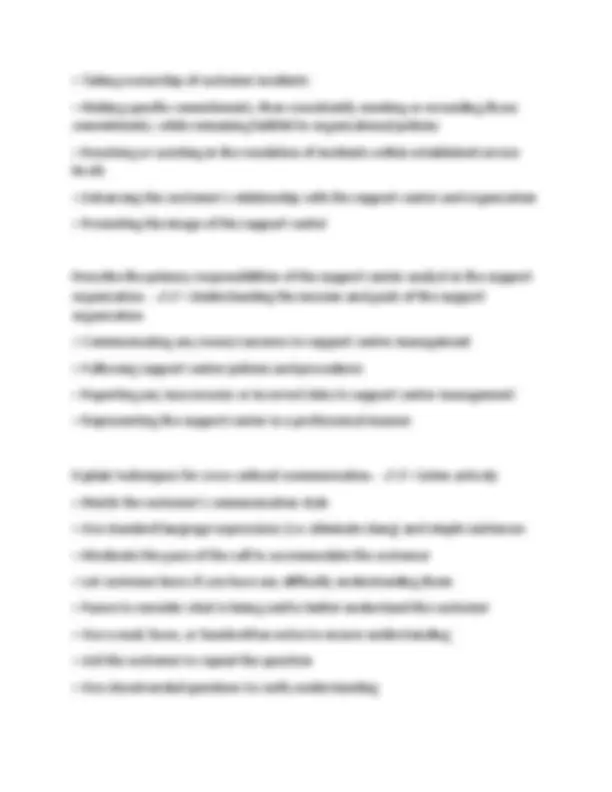
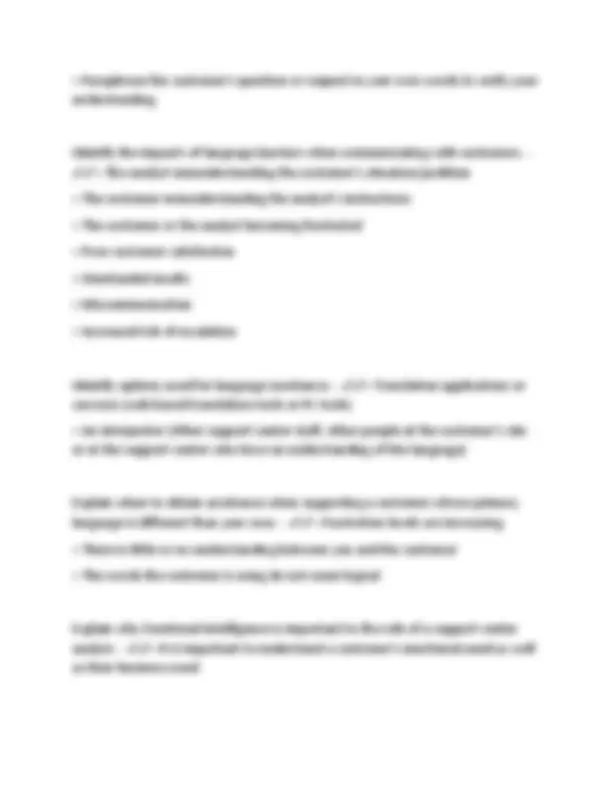
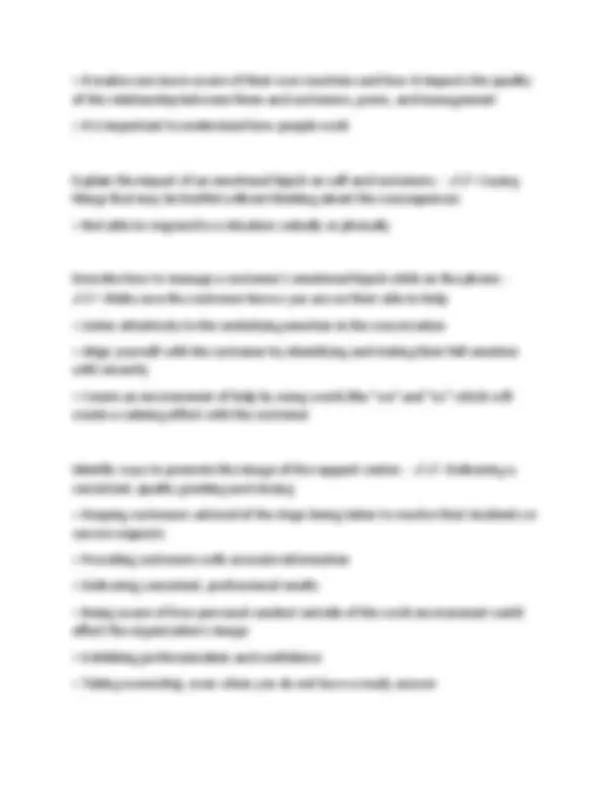
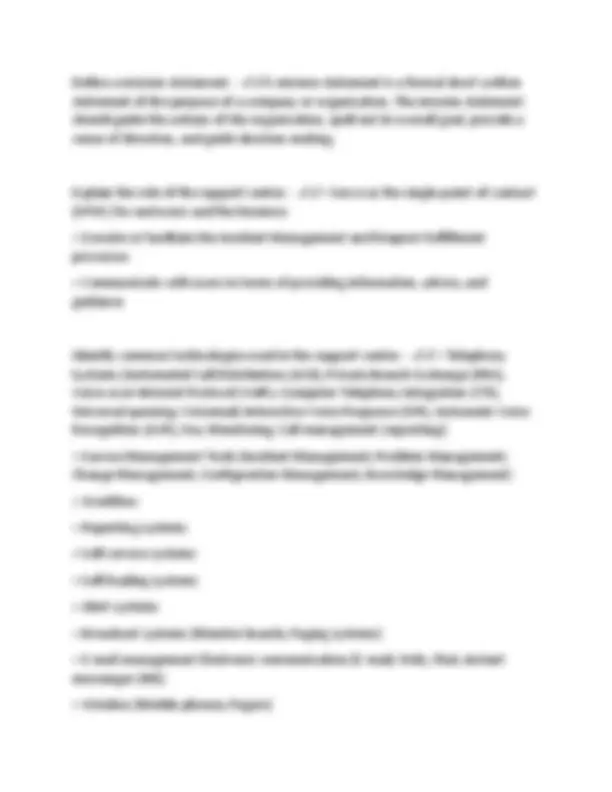
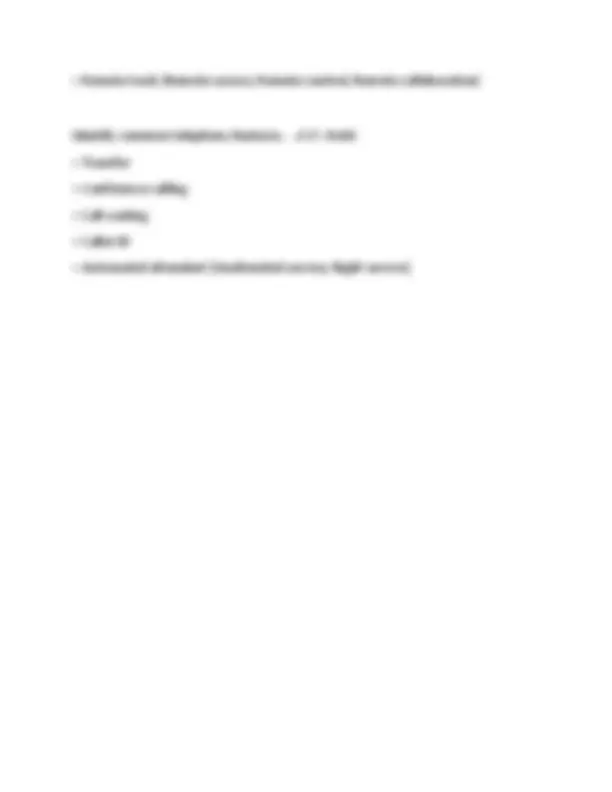


Study with the several resources on Docsity

Earn points by helping other students or get them with a premium plan


Prepare for your exams
Study with the several resources on Docsity

Earn points to download
Earn points by helping other students or get them with a premium plan
Community
Ask the community for help and clear up your study doubts
Discover the best universities in your country according to Docsity users
Free resources
Download our free guides on studying techniques, anxiety management strategies, and thesis advice from Docsity tutors
A wide range of best practices and key concepts for service and support center professionals. It discusses the importance of emotional intelligence, time management, documentation, security policies, customer communication techniques, and quality assurance. Insights into how support center agents can improve their skills, enhance customer satisfaction, and contribute to the overall success of the organization. Key topics include remote control tools, incident escalation, active listening, cross-selling, and leadership characteristics. The information presented can be valuable for both new and experienced support center agents looking to enhance their knowledge and professional development.
Typology: Exams
1 / 22

This page cannot be seen from the preview
Don't miss anything!















What is best practice for building positive working relationships with other groups in the support center? - ✔✔Share your knowledge. What is a key benefit of remote control tools? - ✔✔Decreases the support resources required to store the service. What is the best reason for demonstrating confidence during a call? - ✔✔Puts you in control of the conservation. What is the best description of paraphrasing? - ✔✔Using your own words to confirm your understanding of what the customer has said. Why is it important to recognize a customers psychological needs when resolving incidents? - ✔✔Unresolved psychological issues can have a negative affect on the resolution. What is the most important reason for providing status updates to customers?
Which situation is most appropriate for escalation? - ✔✔You have exhausted all available resources What is the best way to handle requests that are not supported? - ✔✔Advise the customer of other means for getting assistance You have asked a customer to reboot his or her computer. What is the best way to use your silent time? - ✔✔Review the call history. What information should be documented for every incident? - ✔✔All information pertaining to attempted and successful resolutions. What is the best reason for logging all incidents? - ✔✔Provides information that can be reused What is most likely benefit of logging all incidents? - ✔✔It allows the support center to be proactive. You have just received a customer call, but there are other team members laughing and joking around in your area. What is your best course of action? - ✔✔Ask your team members to please quiet down before answering the phone. What is the best reason for having security policies in the service and support center - ✔✔They protect the company and it's customers
about the network team. What is your best way to respond to the customer? - ✔✔Empathize with the customer before addressing the incident. What is first contact resolution? - ✔✔The percentage of incidents resolves during the initial and only interaction with the customer. When is it most appropriate to escalate incidents to a supervisor? - ✔✔Escalate an incident if the incident has a high business or financial impact. What is the best description of a team? - ✔✔A team is a group of people working as one unit. What should you do during the initial diagnosis activity of the Incident Management Process? - ✔✔Search the knowledge base for similar incidents or workarounds. What is the last step in closing a call? - ✔✔Document the information gathered during the call. Describe the top skills most commonly required of a support professional. - ✔✔Customer service Communication skills Ability to learn quickly Troubleshoot/ problem solving skills Ability to work under pressure Interpersonal skills
Teamwork skills Self motivated, independent worker Support experience Explain how a support center analyst demonstrates value to the organization. - ✔✔Performing their role in a consistent quality manner, thus helping the business to achieve its vision and mission Keeping their customers informed, promoting the service offerings to meet the needs of the customers Promoting and educating customers on the services that are available, increasing the utilization of those services Managing customer expectations and following up, increasing visibility to the service and support center which may result in an increase in customer satisfaction and leads to customer loyalty Define Emotional Intelligence (IEI) - ✔✔The ability to recognize and know "in the moment" what emotions you are feeling and what they mean Managing one's emotions so that they do not overwhelm the situation and one's thinking capability Being able to correctly recognize the emotions that others are feeling Helping manage others emotions in order to ensure that those emotions to not overwhelm that situations and their ability to think clearly The ability to create sincere and authentic relationships that produce value and productivity Why is emotional intelligence important as a SCA - ✔✔It is important to understand a customers emotional needs as well as their business needs
Networking and collaborating with other support professionals via webinars, events, and conferences. Joining and participating in industry groups and online support communities Sharing knowledge via white papers, articles, blogs, and knowledge sharing sessions Define strategic planning - ✔✔An organized process to define the organizations desired future state, the high level goals and objectives, and the sequence of actions and tasks to achieve them. Define strategy - ✔✔Documented plan of action to bring about a future state, such as the organizations goals and objectives. Vision statement - ✔✔A vision statement is documented view of the future state of the organization or business unit. It reflects an "ideal" picture of what the organization wants to become as viewed by its stakeholders Identify metrics that may demonstrate how the service and support center contributes to achieving business goals and objectives - ✔✔Customer satisfaction Quality Service Level Agreement (SLA) First Contact Resolution (FCR) First Level Resolution (FLR) Business Impact Analyst Utilization
What is the purpose of organizational policies - ✔✔Provide clear definitions of boundaries within which to work Define what is acceptable and unacceptable employee and customer behavior Provide guidelines for dealing with inappropriate behavior Set customer expectations with defined policies What is the importance of adhering to organizational policies - ✔✔Encourages consistent behavior throughout the business and support organization Provides a framework for the delivery of consistent service and support What is a good practice to help you identify the competency level of a customer?
What is an important benefit of knowledge management? - ✔✔Reduces the time it takes to resolve incidents? What telephony system includes call queuing? - ✔✔Automatic Call Distributor What is a common issue encountered when integrating computer telephony integration with incident management systems? - ✔✔Screen pops can delay the time to answer. What is the primary purpose of a change management process? - ✔✔Enable execution of changes with minimal disruption. What is Knowledge Centered Support? (KCS) - ✔✔A set of best practices for support What is a common quality assurance practice followed by a support center? - ✔✔Monitoring key performance indicators What is an important benefit of a change management process? - ✔✔Facilitates making changes without major impact to the customer What is paraphrasing? - ✔✔Using your own words to repeat to the customer what he said to you
Describe the value of having IT security policies - ✔✔Ensures compliance with legal requirements Addresses security with 3rd parties (suppliers) Provides employees with awareness of their responsibilities Recognizing that a customer's psychological needs must be met when resolving incidents is called? - ✔✔Customer Call Differentiating What is the best way to minimize conflict with a customer? - ✔✔Remain friendly towards the customer. What is the best reason for matching the communication style of your customer?
If the customer is apologetic and seems very concerned about how you will respond to their question, what competency level is S/he at? - ✔✔Unconscious Incompetence If the customer briefly describes his/her problem and then tells you what the fix should be, what level is S/he at? - ✔✔Conscious Competence If a customer does some troubleshooting and even looks into documentation before they call, what level are they? - ✔✔Unconscious Competence What percentage of customer satisfaction consists of meeting the customer's psychological needs? - ✔✔Seventy-five percent (75%) of customer satisfaction consists of meeting the customer's psychological needs. What percentage of customer satisfaction consists of meeting the customer's business needs and providing service and support? - ✔✔Only Twenty-five percent (25%) of customer satisfaction consists of meeting the customer's business needs and providing service and support. What is Customer Competency? - ✔✔The customer's ability to understand and perform a task. What are the Four Customer Competency levels? - ✔✔Unconscious Incompetence Conscious Incompetence Conscious Competence Unconscious Competence
What is a procedure? - ✔✔A procedure is a documented set of steps required to produce a desired result. What is Quality Assurance? - ✔✔A systematic way of ensuring that all the activities necessary to design, develop, and implement services that satisfy the requirements of the organization and of customers take place as planned. An emotional hi-jack occurs when? - ✔✔There is a perceived threat, whether it is real or imagined, from a situation or person. What is Total contact ownership? - ✔✔A best practice procedure that dictates that the customer service representative who takes the initial customer service request or incident will continue to work on the request and follow up with the customer until that issue is resolved to the customer's satisfaction. What is the primary reason for implementing total contact ownership? - ✔✔To ensure customer service satisfaction and the ability to deliver on promised service levels. What are the benefits of using cross-selling and up-selling techniques? - ✔✔An increase in sales volume and customer loyalty. A serious incident has occurred. The solution team assigned to the incident is unable to resolve it within the agreed-upon time frame. The incident is escalated to the incident manager. What type of escalation is this? - ✔✔Hierarchical Escalation
Describe ethical behavior in a support center. - ✔✔> Provide consistent service to all customers
Demonstrate honesty and integrity in their actions Take ownership and hold themselves personally accountable for their actions Fulfill commitments Protect and enhance the image of the support center Are loyal to their team Identify strategies for multitasking in a support environment. - ✔✔> Switch between tasks smoothly throughout the day Prioritize tasks throughout the day as circumstances require, with minimal supervision Organize work effectively Explain how to manage the use of your time efficiently - ✔✔> Planning projects and activities in advance Prioritizing tasks to ensure that you spend time on tasks that contribute to the achievement of your goals Addressing the most important action items first Accurately estimating and planning how long non-routine tasks will take Being more efficient when performing routine tasks Using a time management tool or daily "to-do" list Learning to say "no" when appropriate
Identify considerations for effective use of e-mail communication. - ✔✔> Understanding your audience so that you can tailor and optimize message content
Labeling your message with a subject line that reflects the message content Structuring your message so that it's easy, quick to read and understand -- including an opening, bullet points, and closing Using clear, concise business language so that your message is communicated effectively Proofreading your message before you send it to ensure it is communicating what you intend Using plain text and avoid fancy fonts, colors, and RTF or HTML formatting Including the original message with replies to provide a context for the message Using appropriate punctuation Avoiding abbreviations (e.g. "BTW" instead of "by the way") and emoticons Using appropriate capitalization (avoiding the use of all capital or all lower-case letters)
List ideas for staying informed about industry trends and best practices. - ✔✔> Attending courses and seminars
Networking with other professionals at industry events Subscribing to industry publications Joining industry groups Subscribing to or participating in online discussion groups Identify ways that an SCA can deliver consistent, quality customer service. - ✔✔> Responding to customer incidents in a timely manner Understanding and documenting customer needs
Paraphrase the customer's question or request in your own words to verify your understanding Identify the impacts of language barriers when communicating with customers. - ✔✔> The analyst misunderstanding the customer's situation/problem The customer misunderstanding the analyst's instructions The customer or the analyst becoming frustrated Poor customer satisfaction Unintended insults Miscommunication Increased risk of escalation Identify options used for language assistance. - ✔✔> Translation applications or services (web-based translation tools or PC tools) An interpreter (Other support center staff, other people at the customer's site or at the support center who have an understanding of the language) Explain when to obtain assistance when supporting a customer whose primary language is different than your own. - ✔✔> Frustration levels are increasing There is little or no understanding between you and the customer The words the customer is using do not seem logical Explain why Emotional Intelligence is important to the role of a support center analyst. - ✔✔> It is important to understand a customer's emotional need as well as their business need
It makes one more aware of their own reactions and how it impacts the quality of the relationship between them and customers, peers, and management It is important to understand how people work Explain the impact of an emotional hijack on self and customers. - ✔✔> Saying things that may be hurtful without thinking about the consequences Not able to respond to a situation verbally or phsically Describe how to manage a customer's emotional hijack while on the phone. - ✔✔> Make sure the customer knows you are on their side to help Listen attentively to the underlying emotion in the conversation Align yourself with the customer by identifying and stating their felt emotion with sincerity Create an environment of help by using words like "we" and "us" which will create a calming effect with the customer Identify ways to promote the image of the support center. - ✔✔> Delivering a consistent, quality greeting and closing Keeping customers advised of the steps being taken to resolve their incidents or service requests Providing customers with accurate information Delivering consistent, professional results Being aware of how personal conduct outside of the work environment could affect the organization's image Exhibiting professionalism and confidence Taking ownership, even when you do not have a ready answer